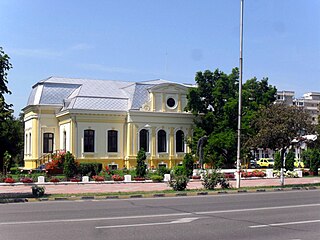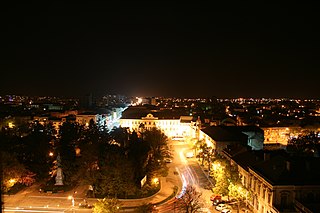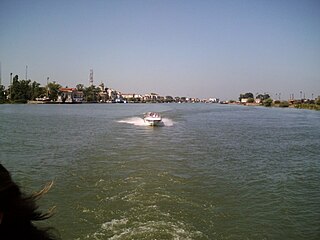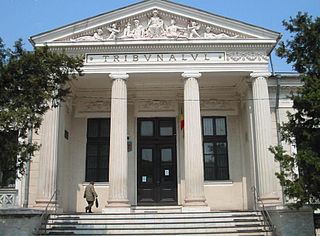
Wallachia or Walachia is a historical and geographical region of modern-day Romania. It is situated north of the Lower Danube and south of the Southern Carpathians. Wallachia was traditionally divided into two sections, Muntenia and Oltenia. Dobruja could sometimes be considered a third section due to its proximity and brief rule over it. Wallachia as a whole is sometimes referred to as Muntenia through identification with the larger of the two traditional sections.

Bacău is the main city in Bacău County, Romania. With a population of 136,087, Bacău is the 14th largest city in Romania. The city is situated in the historical region of Moldavia, at the foothills of the Carpathian Mountains, and on the Bistrița River. The Ghimeș Pass links Bacău to the region of Transylvania.

Brăila is a city in Muntenia, eastern Romania, a port on the Danube and the capital of Brăila County. The Sud-Est Regional Development Agency is located in Brăila.

Isaccea is a small town in Tulcea County, in Northern Dobruja, Romania, on the right bank of the Danube, 35 km north-west of Tulcea. According to the 2021 census, it has a population of 4,408.

Sulina is a town and free port in Tulcea County, Northern Dobruja, Romania, at the mouth of the Sulina branch of the Danube. It is the easternmost point of Romania.

Turnu Măgurele is a city in Teleorman County, Romania, in the historical region of Muntenia. Developed nearby the site once occupied by the medieval port of Turnu, it is situated north-east of the confluence between the Olt River and the Danube, at the edge of the Wallachian Plain.

The University of Bucharest (UB) is a public research university in Bucharest, Romania. It was founded in its current form on 4 July 1864 by a decree of Prince Alexandru Ioan Cuza to convert the former Princely Academy into the current University of Bucharest, making it one of the oldest Romanian universities. It is one of the five members of the Universitaria Consortium.
Pereyaslavets or Preslavets was a trade city located near mouths of the Danube. The city's name is derived from that of the Bulgarian capital of the time, Preslav, and means Little Preslav. In Greek it was also known as Presthlavitza (Πρεσθλαβίτζα). Several theories exist regarding the exact location of the city: either at Preslav or in its vicinity in Bulgaria, or at Isaccea, Nufăru, Murighiol or Jurilovca in Romania.

The House of Basarab was a ruling family of Cuman origin, which had an important role in the establishing of the Principality of Wallachia, giving the country its first line of Princes, one closely related with the Mușatin rulers of Moldavia. Its status as a dynasty is rendered problematic by the official elective system, which implied that male members of the same family, including illegitimate offspring, were chosen to rule by a council of boyars. After the rule of Alexandru I Aldea, the house was split by the conflict between the Dănești and the Drăculești, both of which claimed legitimacy. Several late rulers of the Craiovești claimed direct descent from the House after its eventual demise, including Neagoe Basarab, Matei Basarab, Constantin Șerban, Șerban Cantacuzino, and Constantin Brâncoveanu.

Greeks are a historic minority group in Romania. At times, as during the Phanariote era, this presence has amounted to hegemony; at other times, the Greeks have simply been one among the many ethnic minorities in Romania.

Baia is a commune in Suceava County, in the historical region of Western Moldavia, northeastern Romania with a population of 6,793. It is composed of two villages, namely Baia and Bogata. Located on the Moldova River, it was one of the earliest urban settlements in Moldavia.

The Despotate of Dobruja or Principality of Karvuna was a 14th-century quasi-independent Bulgarian polity in the region of modern Dobruja, that split off from the Second Bulgarian Empire under the influence of the Byzantine Empire. The Despotate of Dobruja existed from 1356 to 1411.

The Saint Sava National College, Bucharest, named after Sabbas the Sanctified, is the oldest and one of the most prestigious high schools in Romania. It was founded in 1694, under the name of the Royal Academy of Bucharest.

Dobrotitsa was a Bulgarian noble, ruler of the de facto independent Principality of Karvuna and the Kaliakra fortress from 1354 to 1379–1386.
The founding of Wallachia, that is the establishment of the first independent Romanian principality, was achieved at the beginning of the 14th century, through the unification of smaller political units that had existed between the Carpathian Mountains, and the Rivers Danube, Siret and Milcov.

Târgșor is a former medieval market town in what is now Prahova County, Romania. The town peaked around 1600, after which it declined to become the village of Târgșoru Vechi, located about 7 km (4.3 mi) southwest of Ploiești.
During the Mongol invasion of Europe, Mongol tumens led by Batu Khan and Kadan invaded Serbia and then Bulgaria in the spring of 1242 after defeating the Hungarians at the battle of Mohi and ravaging the Hungarian regions of Croatia, Dalmatia and Bosnia.

Andronikos Kantakouzenos, also known as Mihaloğlu Derviş, was an Ottoman Greek entrepreneur and political figure, primarily active in Wallachia and Moldavia. He was the son of Michael Kantakouzenos Şeytanoğlu, a powerful merchant of the Ottoman Empire, executed by Murad III in 1578. Forced to honor his father's outstanding debt, and briefly imprisoned as a galley slave, he rebuilt the fortune through commerce and political intrigues. In the 1590s, he was continuing his father's involvement as kingmaker for both Wallachia and Moldavia, acting as patron for a succession of Hospodars: Stephen the Deaf, Petru Cercel, Aaron the Tyrant and Peter the Lame all benefited from his financing. From 1591, he involved himself directly in the administration of both countries. Integrated within Moldo–Wallachian boyardom, he was Vistier, and then the first-ever Ban of Oltenia to be appointed directly by the Ottomans.

The military of Wallachia existed throughout the history of the country. Starting from its founding to 1860, when it was united with the Moldavian army into what would become the Romanian Army.


















